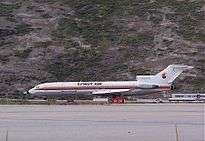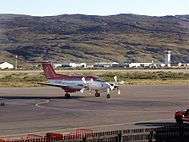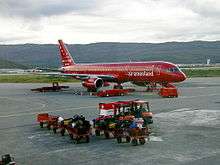Kangerlussuaq Airport
| Kangerlussuaq Airport Mittarfik Kangerlussuaq Kangerlussuaq Lufthavn | |||||||||||
|---|---|---|---|---|---|---|---|---|---|---|---|
|
| |||||||||||
| Summary | |||||||||||
| Airport type | Public | ||||||||||
| Operator |
Greenland Airport Authority (Mittarfeqarfiit) | ||||||||||
| Serves | Kangerlussuaq, Greenland | ||||||||||
| Location | Kangerlussuaq, Qeqqata, Greenland | ||||||||||
| Hub for | Air Greenland | ||||||||||
| Elevation AMSL | 165 ft / 50 m | ||||||||||
| Coordinates | 67°01′01″N 050°41′22″W / 67.01694°N 50.68944°WCoordinates: 67°01′01″N 050°41′22″W / 67.01694°N 50.68944°W | ||||||||||
| Website | Kangerlussuaq Airport | ||||||||||
| Map | |||||||||||
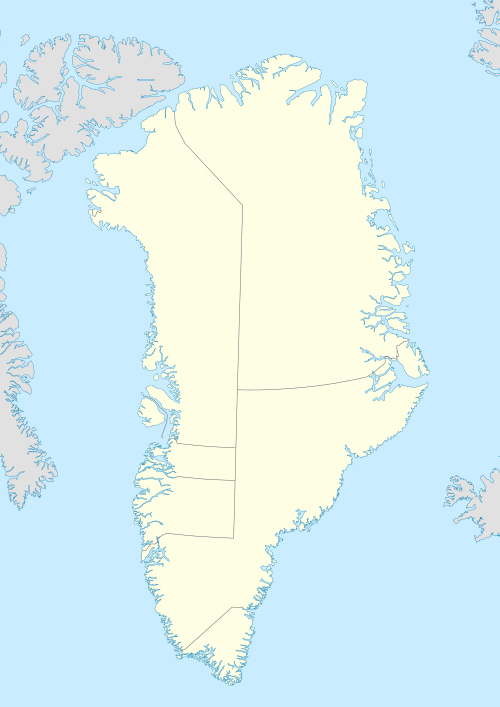 BGSF Location in Greenland | |||||||||||
| Runways | |||||||||||
| |||||||||||
| Statistics (2012) | |||||||||||
| |||||||||||
Kangerlussuaq Airport (Greenlandic: Mittarfik Kangerlussuaq, Danish: Søndre Strømfjord Lufthavn) (IATA: SFJ, ICAO: BGSF) is an airport in Kangerlussuaq, a settlement in the Qeqqata municipality in central-western Greenland. Alongside Narsarsuaq Airport, it is one of only two civilian airports in Greenland large enough to handle large airliners. It is located away from the coast and hence less prone to fog and wind in comparison with other airports in Greenland. Kangerlussuaq Airport is the international hub for Air Greenland. The Kangerlussuaq area has very few inhabitants, around 500, so few passengers have their origin or destination here. Most passengers change planes.
History
The first airport was built here during the US occupation in 1941 under the name of Bluie West-8, later renamed Sondrestromfjord Air Base and Sondrestrom Air Base.
In the 1950s, transatlantic civilian flights began using the air base for refuelling. This use fell off in the 1960s as airliners gained greater range, but the base became the hub of Greenland air traffic.
The airport was handed over to civilian Greenlandic control in 1992.
Future
At a late 2011 Air Greenland meeting, plans to move the main Greenland intercontinental air hub away from Kangerlussuaq were agreed upon. According to the 2011 plan three 1,199-meter airstrips will be built; a new airport at Qaqortoq, and extensions at Nuuk, and Ilulissat. New airports will probably also be built at Tasiilaq and Ittoqqortoormiit later. These planned airstrips will be too short to host intercontinental flights, and a new 1,799-meter airstrip must be built before Kangerlussuaq can be closed. The main candidates for a new intercontinental airport are presently Nuuk and Qaqortoq. Alongside Kangerlussuaq, the airports at Narsarsuaq and Kulusuk (if Tasiilaq is built) will also be closed.[3] Generally, a number of the airstrips have been built by the US military at locations deliberately away from major settlements, partly due to the Danish policy to downplay the presence of the US military in Greenland. There is also a need to renovate the Kangerlussuaq runway for fairly high cost as the permafrost is melting under it.[4]
A decision was made in 2016 to extend the runways of both Nuuk airport and Illulisat airport to 2,200 m (7,200 ft), allowing them to receive medium size jetliners from Denmark.[5][6] Also to replace Narsarsuaq with a new airport at Qaqortoq. Construction start of Nuuk is expected late 2018.[7] This, in combination with the runway state, will probably mean that Kangerlussuaq will be closed or used for smaller planes only, not to Denmark.
Airlines and destinations
Passenger
| Airlines | Destinations |
|---|---|
| Air Greenland | Aasiaat, Copenhagen, Ilulissat, Maniitsoq, Narsarsuaq, Nerlerit Inaat, Nuuk, Reykjavík–City, Sisimiut |
| Air Iceland Connect | Seasonal: Ilulissat,[8][9] Reykjavík–Keflavík[10] |
Access to several research camps on the Greenland ice sheet, including the Danish field camp North GRIP and the American Summit Camp, is handled through Kangerlussuaq via the 109th Airlift Wing of the New York Air National Guard. There are also a few tourist charter flights between Germany and Kangerlussuaq every summer, in connection with cruise ship arrivals to the Kangerlussuaq seaport. Those flights have typically been operated by Air Greenland or airlines from Germany.[11] Other charter flights can appear, for example a number of flights from especially US and Canada landed in connection with the 2016 Arctic Winter Games in Nuuk.
Freight
The flights from Copenhagen using the large aircraft is the main way of quick transport of goods and mail to Greenland. This includes fresh food. Because of the lack of a good port at Kangerlussuaq, most of it is transported by air to other destinations. Goods that don't need such quick transport are freighted by air to Nuuk and then by ship to other places in Greenland. A road to Sisimiut at the coast is planned with this freight in mind. In general there are worries about cost, and furthermore the uncertanty of the future of Kangerlussuaq makes it hard to decide upon a road or a port.
Facilities
The terminal is open for 24 hours during summer. Hotel Kangerlussuaq, with a 70-room capacity and a restaurant, is located within the terminal building of the airport, providing accommodation for transferring passengers. Other amenities include a night-club and a self-service bar during daytime. Several tourism outfitters share an office in the terminal, alongside the Tourist Office. There are two other more simple accommodations in Kangerlussuaq.
Accidents and Incidents
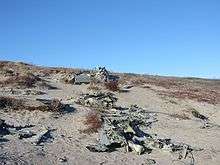
- In 1961, a DHC-3 Otter, operated by Greenlandair, crashed at emergency landing in terrain near Kangerlussuaq, because of a fire on board. One crew member was killed. There were 2 crew and 4 passengers on board.[12]
- In 1968, three US T-33 fighters crashed into a nearby mountain. All on board (one per plane) survived by parachute.
- In 1976, a US Air Force C-141A cargo plane crashed, killing 23 of 27 passengers and crew on board.[13]
See also
References
- ↑ Greenland AIP for BGSF – Kangerlussuaq Airport from Naviair
- ↑ "Dropbox - Operationer og pax 2012-1988.xls". Dropbox.
- ↑ "Kangerlussuaq to be closed". Sermitsiaq, AG. Retrieved 5 January 2012.
- ↑ Grønland vil udvide og nybygge fem lufthavne (Danish)
- ↑ "Nuuk - Kalaallit Airports A/S". kair.gl. Retrieved 28 June 2018.
- ↑ "Ilulissat - Kalaallit Airports A/S". kair.gl. Retrieved 28 June 2018.
- ↑ "Pressemeddelelse: Egenkapitalfinansiering og tidsplan for nye lufthavne i Ilulissat, Nuuk og Qaqortoq på plads - Kalaallit Airports A/S". kair.gl. Retrieved 28 June 2018.
- ↑ "Historical Flight Status". flightstats.com.
- ↑ "Direct flights from Reykjavík to Kangerlussuaq in Greenland in 2016". Iceland Magazine. 22 September 2015. Retrieved 22 September 2015.
- ↑ 2018, UBM (UK) Ltd. "Air Iceland S16 Greenland Operation Changes". airlineroute.net. Retrieved 28 June 2018.
- ↑ "Grönland, Island & Nordatlantische Inseln - Kreuzfahrt". post-reisen.de.
- ↑ Harro Ranter (29 August 1961). "ASN Aircraft accident de Havilland Canada DHC-3 Otter CF-MEX Kangerlussuaq-Søndre Strømfjord Airport (SFJ)". aviation-safety.net.
- ↑ Harro Ranter (28 August 1976). "ASN Aircraft accident Lockheed C-141A-LM Starlifter 67-0008 Kangerlussuaq-Søndre Strømfjord Airport (SFJ)". aviation-safety.net.
External links
![]()


